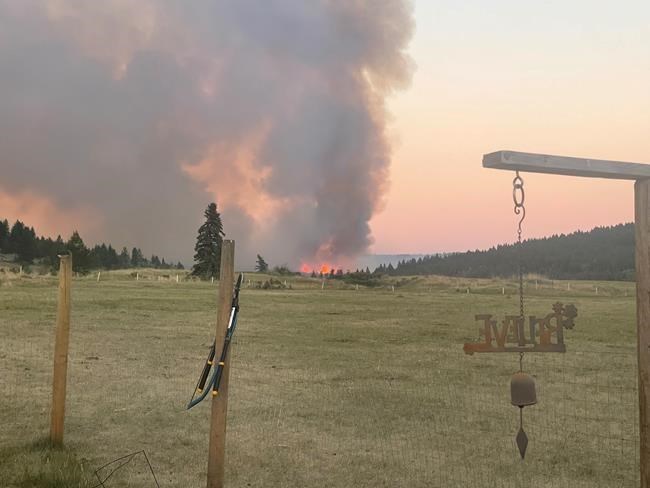LYTTON, B.C. — A fast-spreading wildfire led to an immediate evacuation order Wednesday night for residents of the British Columbia village of Lytton as many scrambled to escape as flames threatened buildings.
Mayor Jan Polderman issued the evacuation order at 6 p.m. local time. It said the wildfire was threatening structures and the safety of residents, who dealt with a high temperature of 49.6 C on Tuesday as a heat wave affected many parts of the province.
"All residents are advised to leave the community and go to a safe location," Polderman said.
In a tweet, Premier John Horgan described the fire situation as "extremely dangerous" and said emergency crews were doing "everything they can to support the people of Lytton."
Erica Berg, a provincial fire information officer, said the evacuation order was issued about an hour after the blaze began but she did not know the size of the wildfire.
"We're in intense response mode so our main priority is getting resources to the area," she said, adding multiple fire engines had been sent to Lytton from various locations.
The village, which lists its population at about 250 people as of 2016, smashed a Canadian record for high temperatures three days in a row this week during an ongoing historic heat wave. Lytton is about a two-hour drive southwest of Kamloops.
Later Wednesday night, the Thompson-Nicola Regional District issued an evacuation order affecting 87 properties in an area north of Lytton.
Scott Hildebrand, chief administrative officer of the regional district, said the evacuation order for the village was issued as soon as possible.
"It didn't matter because people were already fleeing," he said, adding smoke blanketed the area within minutes and structures were burning as residents left.
Hotel rooms around the area were already booked by people seeking relief from the heat wave and by those getting away for Canada Day as most COVID-19 restrictions in the province were lifted, as well as by crews working on a pipeline project, Hildebrand said.
He said about 1,000 people in First Nations communities may also be ordered to evacuate, but it was hard to get in contact with their local governments.
"It happened so quickly that we're struggling to connect with everybody because power is down, cellphone lines are down. It's a tough situation."
Hildebrand said a reception centre has been set up in Kamloops but some people may have gone to Merritt or Boston Bar.
"That direction was the safest, I think. That's part of our struggle now is that we don't have people registered and we don't understand exactly where everybody went."
Jo-Anne Beharrell and Marshall Potts were ordered from their home on Tuesday, a day before the latest evacuation alert.
They first spotted the fire around 5 p.m. on Monday from their kitchen window when it was about 1.5 kilometres from their front yard.
"It looked like, you know, a small brush fire but we knew there was a problem," Potts said in an interview Wednesday evening from Pinantan Lake, just outside of Kamloops where the couple are staying with family.
Beharrell said the heat wave has made the area “very dry, very dusty."
"I'm telling you it was like being in the desert," she said.
They drove back to the village Wednesday afternoon to check on their friends and neighbours.
"There's a massive, massive white cloud over the whole area," Beharrell said.
"It definitely feels dystopian, that's for sure. It definitely feels apocalyptic."
Major highways in the area, including the Trans-Canada Highway, were closed because of the fire.
Lytton Coun. Robert Leitch said the fire that caused the evacuation order started south of town around 5:15 p.m. and spread within 15 minutes, and that's when he left.
"When I first saw the smoke at the south end of town coming up really fast, I told my partner that, well, you know, that fire is breaking inside the village. Let's get our stuff in the truck," he said, adding that they are staying with friends in Ashcroft.
"So we went around, backed up the truck, packed everything up, knocked on a few neighbours' doors, and by that time the fire was already 100 metres from my house."
Berg said earlier Wednesday that wildfire service members were battling another small fire near Lytton, in the same area where crews have been working to control the 0.5-square kilometre George Road fire, which forced evacuation alerts after breaking out last week.
The blaze was among three major wildfires in British Columbia's southern Interior.
The BC Wildfire Service said the McKay Creek fire had charred 50 square kilometres in the Pavilion area just north of Lillooet, while flames had burned at least 40 square kilometres around Sparks Lake, about 15 kilometres north of Kamloops.
The Squamish-Lillooet Regional District issued evacuation orders for more than two dozen properties west of Pavilion. The Thompson-Nicola Regional District also posted orders for 18 properties in the Sparks Lake area outside Kamloops, while about 150 nearby camps and cabins were on alert.
All three fires are suspected to be human-caused, although they remained under investigation.
The Peace River Regional District issued an evacuation order Wednesday night as well for areas south of Prince George, but it did not indicate the number of properties affected.
Berg said there have been 26 new fires in the last two days as the risk across most of the province is rated at high to extreme.
Campfires were banned across the province as of noon Wednesday.
— By Camille Bains and Hina Alam in Vancouver.
This report by The Canadian Press was first published June 30, 2021.
The Canadian Press




